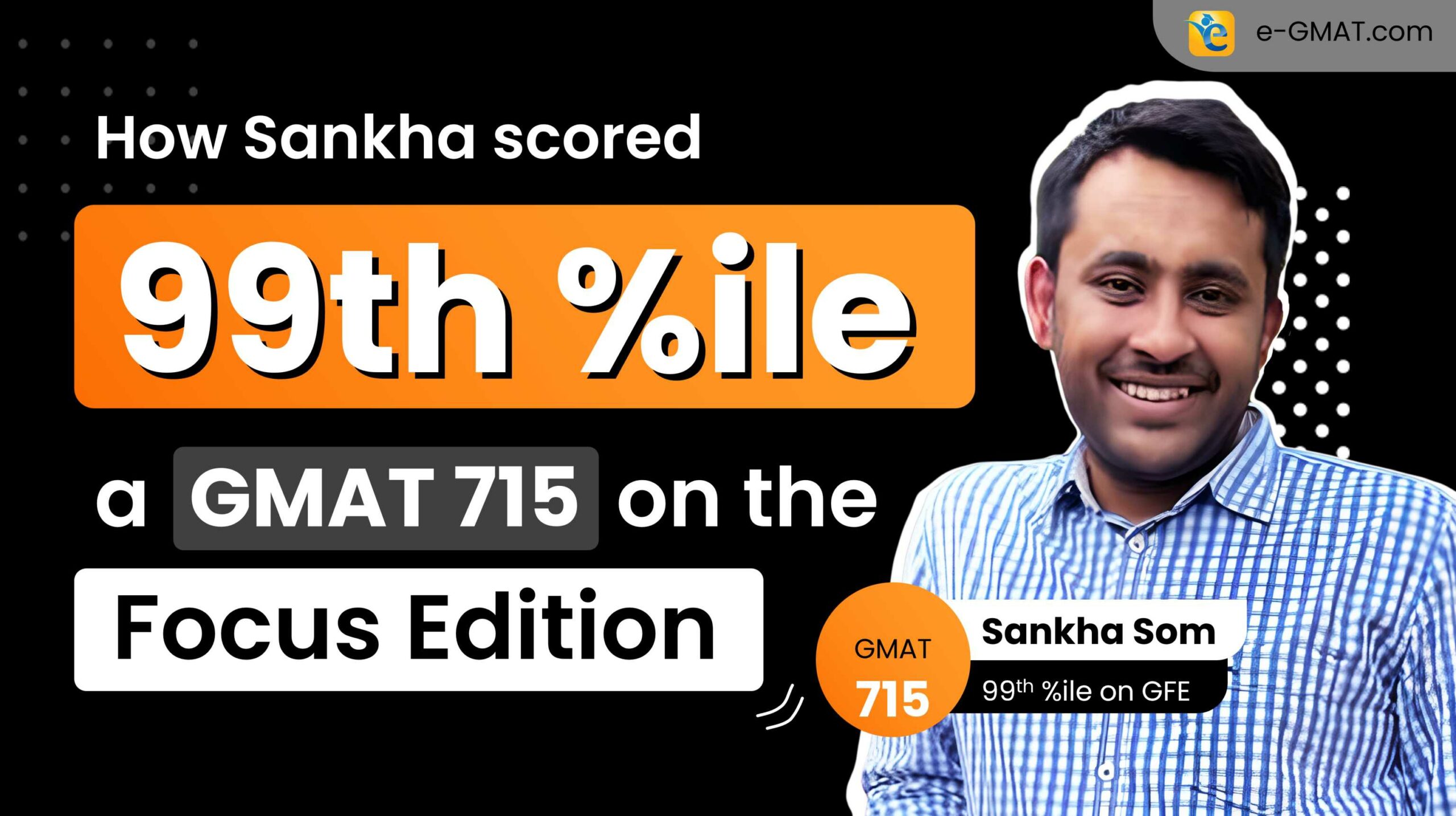Most of us put in a great deal of effort to prepare for GMAT, spend money on the best of resources, and burn the midnight oil. Yet, there are some who improve tremendously (10+ points out of 60, or 100+ out of 800) and come through with flying colors, while there are others who don’t perform as well and are not able to achieve their targeted GMAT Verbal Score. At e-GMAT, we study learning and success on test prep very closely. In this article, we will analyze three behaviors that are leading indicators signaling that you will likely not score as well as you expect to. Look out for these symptoms in your preparation phase. If you face any of these challenges, you need to reconsider your preparation strategy!
In this article, we’ll look at 3 reasons why you may not achieve your target GMAT Verbal Score:
- Reason 1 – Lack of confidence in your answer
- Reason 2 – You narrow down to 2 choices and then get confused
- Reason 3 – After taking a mock, you feel hopeless
How to achieve your target GMAT Verbal Score?
1. Your accuracy is high but you are not sure why the correct answer is correct
 I have seen many students say that their accuracy is high (80%) while solving OG but they are not sure as to why the correct answer is correct, or for that matter, why the incorrect answer is incorrect. They often say that the correct answer just seems “better” than the incorrect one. Hence, more often than not, these students are not very confident of their answers. These students take the high accuracy as a proxy for good performance on the exam. While a high accuracy is necessary, it is by no means a sufficient condition to perform well on the real test.
I have seen many students say that their accuracy is high (80%) while solving OG but they are not sure as to why the correct answer is correct, or for that matter, why the incorrect answer is incorrect. They often say that the correct answer just seems “better” than the incorrect one. Hence, more often than not, these students are not very confident of their answers. These students take the high accuracy as a proxy for good performance on the exam. While a high accuracy is necessary, it is by no means a sufficient condition to perform well on the real test.
There are two key differences between solving a question from OG and solving the same on the real GMAT:
- On the real GMAT, one is faced with questions from different topics such as SC, CR, RC simultaneously
- One has to solve questions under time constraints
In fact, these students, more often than not, falter on the real exam. This is because as they move from one question to the other, in the back of their minds, they are concerned whether they solved the previous question correctly or not, and hence are not able to devote their full attention to the question in front of them. Hence, they not only take longer to solve the current question, but also are not confident about their answer. This results in a vicious circle due to which the accuracy precipitates and so do the scores.
Learn how Anupriya leveraged Verbal to score a 760 (V46) on the GMAT. Read her success story.
On the other hand, a student who is confident of his answers and arrives at the correct answer for the right reasons is less likely to fall into this trap. Hence, this student after solving a question is not likely to think about the same and puts his entire focus on the question that he is attempting. As a result, he/she is much more likely to maintain his/her accuracy when solving problems of different kinds one after another. Even when faced with time pressure, his/her accuracy does not precipitate because the student can reason out why the correct answer is correct and the incorrect answer is incorrect.
For any further doubts, you can write to us at acethegmat@e-gmat.com and our strategy experts can help you out.
OG problems with Application files: The 30+ application files in e-GMAT course teach you how to approach problems, how test makers formulate answer choices, and how to select the correct answers and reject the incorrect answers for the right reasons – Thereby enabling you to get a high GMAT Verbal Score. Solving the recommended OG questions after the application files is useful because it builds on the capabilities developed while going through the e-GMAT course.
2. You are able to narrow down to 2 answer choices but then you get confused

First of all, to be very clear, the above happens. Even the best of us find ourselves in situations when we are down to two answer choices and cannot decide on the correct answer. However, regardless of whether we solve the question correctly or incorrectly, we always make sure that we avoid being in that situation again. Why – because we know that for official questions, there is only one correct answer and that the dilemma is a result of the gap in our understanding. We acknowledge our shortcomings and take concrete steps towards fixing the gap and 9/10 times this prevents us from making the same mistake again.
Those who stop their analysis at “I am able to narrow down to 2 answer choices but then I get confused”, don’t believe that there is a gap in their understanding or approach and hence do not take the required corrective action(s). They congratulate themselves for having been able to narrow down the choices from five to two and do not spend the time to understand why the correct answer is correct and how can they avoid making the same mistakes again. Because these people don’t work on bridging the gaps in their understanding, they continue to make the same mistakes, and hence they do not improve.
Amol improved his GMAT Verbal Score from a V17 to V40 – GMAT 520 to 710 using Verbal Live Prep
- He tried books and coaching institutions- but nothing worked.
- He mastered e-GMAT’s “3-step process in SC” and “Pre-thinking in CR” to improve
- He religiously followed the e-GMAT’s methodical approach
3. After a mock, you are at a loss as to how to move forward
 The primary OBJECTIVE to take a mock is to understand how far you are from your target score and to understand the areas that you need to improve in. After properly analyzing a mock, you should be able to list three areas that you need to improve. If you are unable to do the same, then it could mean one of the two things: either you are satisfied with your current score and have little desire to improve or you don’t believe that spending time on analysis will lead to something worthwhile. In other words, you are lazy or scared to analyze your mistakes. Trust me; most of you are smart enough to analyze the mocks.
The primary OBJECTIVE to take a mock is to understand how far you are from your target score and to understand the areas that you need to improve in. After properly analyzing a mock, you should be able to list three areas that you need to improve. If you are unable to do the same, then it could mean one of the two things: either you are satisfied with your current score and have little desire to improve or you don’t believe that spending time on analysis will lead to something worthwhile. In other words, you are lazy or scared to analyze your mistakes. Trust me; most of you are smart enough to analyze the mocks.
If you don’t do a thorough analysis and are unable to come up with three areas where you can improve, then most of your post mock work will be brute force effort, resulting in little improvement as you go from one mock to another. The higher your score, the more profound this problem becomes. This is one reason why many people remain stuck between 32 and 35 for the GMAT Verbal Score. (Refer our article for understanding GMAT Scores)
- Chintan gave too many mocks in his first attempt and ended up getting only a 630. In his second attempt, he realized his mistake, followed a methodical approach, got his fundamentals strong and improved to a 710. Click here to read his de-brief.
- Murali (740) started his GMAT journey only by practicing from OG. Soon realized that it requires a methodical approach to ace GMAT and leveraged GMAT Online Course to reach his target score. Click here to read his amazing debrief.
Take a free GMAT mock to understand your baseline score and start your GMAT prep with our free trial. We are the most reviewed online GMAT Prep company with 2160+ reviews on GMATClub.














